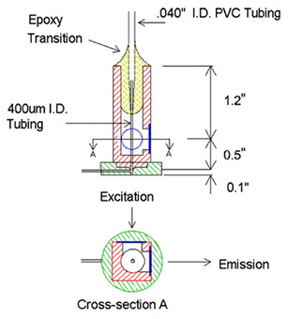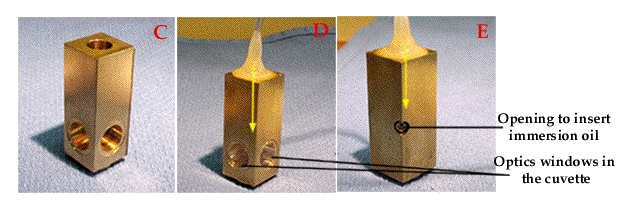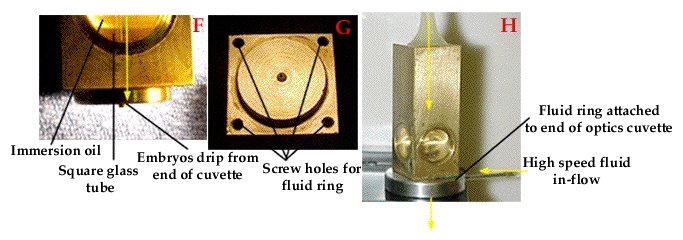 |
||||||
| Optics Cuvette | ||||||
| Optics Chamber | ||||||
| Sorting Switch | ||||||
| Assembly | ||||||
| Electronics | ||||||
| System Timing | ||||||
| Computer Display | ||||||
| Parts List | ||||||
| Contacts | ||||||
Embryo Sorter Website Eileen Furlong, David Profitt, Matthew Scott |
Optics Cuvette
The cuvette serves several functions: 1) to isolate the fluid system from the optical system as much as possible, 2) to deliver embryos to the excitation light in a single file fashion, and 3) to emit embryos from the system in a fluid stream that is easily diverted. From the beginning it became apparent that occasional plugging would be unavoidable. For this reason having the cuvette easily removable is also of benefit. The dimensions of the optical cuvette are shown below.
Optics Cuvette
Diagram

In order to achieve the goal of delivering the embryos in a single file manner, the inside dimensions of the delivery tube must be such that two embryos cannot exist side by side. Tubing with such small dimensions causes high resistance to fluid flows, necessitating either high pressures or excessively slow flow rates. We overcame this problem by using relatively large diameter tubing for the collection and transfer of the embryos (0.030" I.D.), and transitioning gradually to a smaller dimension glass detection tube (0.4 mm I.D. square glass tube). This gradual transition allows the embryos to accelerate before entering the much faster fluid flow of the small glass tube. This approach dramatically reduced the frequency of clogging. The transition was fabricated by making an epoxy cast over a stylus tapered to the inside dimensions of the glass tube.
Mold and Stylus Pictures

Panel A shows the mold used to make the epoxy junction between the tubing and the square glass tube. The fine end of the stylus is initially placed inside the square glass tube (panel B). The two halves of the mold are then assembled and epoxy resin is injected into the mold. Once hardened the stylus was removed, leaving the glass tube in place. Secondly, a tube was inserted in place of the stylus and sealed with an adhesive.
Cuvette
Pictures

This wide diameter tubing-0.4 mm diameter glass tube-epoxy assembly was placed inside a brass ‘cuvette’ (panel C) and glued into place. (Note that we used brass for this purpose due to the ease of machining brass. Manufacturing this piece from a non-corrosive material would increase the life span of the cuvette). The cuvette has two windows perpendicular to each other. One window allows the laser light to excite the embryos as they pass through the square tube and the second window allows the emitted light from the embryos to be detected by the PMTs. The windows are covered by 12 mm #1 coverslips (panel D). The inside of the cuvette, surrounding the square glass tube, was filled with immersion oil using a small opening on the other side of the cuvette (panel E).
Jacketing the glass tube with immersion oil has several advantages. Because the indices of refraction at the excitation light and glass tube interface are nearly equal, excitation light "scatter" is reduced. Also, the oil has the effect of reducing the angle at which the emission light exits the glass tube. This allows the use of a smaller light collection lens, at a distance farther from the point of excitation.
More Cuvette Pictures

When the fluid reaches the end of the glass tube (the glass air interface) it puddles until a drip is formed (panel F). The embryos entering this drip then mix, defeating our goal of sorting. To prevent this puddling, the flow rate is increased until the fluid exits the system in a continuous stream. Panel G is an end-on view of the optics cuvette, showing the central opening where the embryos exit. A metal ring (Fig 2 in paper, see also diagram above) is firmly attached onto the end of the cuvette via 4 screws. The ring injects fluid from a second peristaltic pump into the embryo stream as it exits the glass tube, resulting in a high velocity stream of fluid exiting its orifice. Increasing the fluid flow after the point of detection has two advantages: 1) it allows the embryos to travel at a much slower rate through the point of detection and 2) it allows the sorting switch to operates at moderate speeds, greatly simplifying its design.